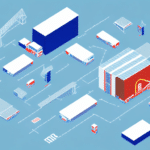How to Achieve Faster Onboarding When You Switch Fulfillment Companies
Are you considering switching fulfillment companies but worried about the onboarding process? Onboarding can be a challenging and time-consuming process, but it's a critical step to ensure a smooth transition and continuity in your business operations. In this article, we'll share some best practices to achieve faster onboarding when you switch fulfillment companies.
Why Switching Fulfillment Companies Can Be a Challenge for Onboarding
Switching fulfillment companies may seem like a simple task, but it can be a complex process that requires careful planning, coordination, and communication. Each fulfillment company has its own onboarding procedures, which can vary widely in terms of documentation, training, and timelines. Additionally, switching fulfillment companies may involve transferring large amounts of inventory, changing order management systems, and reconfiguring shipping and tracking processes.
One of the biggest challenges of switching fulfillment companies is the potential for disruptions to the supply chain. Any delays or errors in the transition process can result in lost sales, dissatisfied customers, and damage to your brand reputation. According to a ShipScience Supply Chain Report, companies that experience disruptions during onboarding can see a decrease in customer satisfaction by up to 20%. It is important to have a detailed plan in place to minimize these risks and ensure a smooth transition.
Another factor to consider when switching fulfillment companies is the cost. While a new fulfillment company may offer lower rates, there may be hidden fees or additional costs associated with the transition process. It is important to carefully review the contract and pricing structure to ensure that you are getting the best value for your business.
Assessing Your Current Onboarding Practices for Fulfillment Companies
The first step in achieving faster onboarding is to assess your current onboarding practices. Evaluate your current fulfillment company and identify the areas that require improvement, such as the time it takes to onboard new products, the length of the training process, or the complexity of the fulfillment process. By understanding the gaps in your current process, you can develop strategies to streamline and optimize the onboarding process.
One effective strategy for improving onboarding is to create a standardized onboarding process that can be easily replicated for each new product or client. This can include creating a checklist of tasks that need to be completed during the onboarding process, as well as providing clear instructions and training materials for new hires. By standardizing the process, you can reduce the time and resources required for each onboarding, while also ensuring that each new hire receives the same level of training and support.
Understanding the Importance of Streamlining Onboarding for Your Business
Streamlining the onboarding process can help your business in several ways. First, it can reduce the time it takes to onboard new products or services, which can speed up your time-to-market and improve your overall business agility. According to industry studies, companies that optimize their onboarding processes can decrease time-to-market by up to 30%. Second, it can reduce costs associated with onboarding, such as setup fees, training costs, and lost productivity during the transition period. Finally, it can improve customer satisfaction by ensuring a smooth transition and uninterrupted service.
Moreover, streamlining the onboarding process can also help your business retain new employees and customers. A smooth and efficient onboarding experience can make new employees feel welcomed and valued, which can lead to higher job satisfaction and lower turnover rates. Similarly, a seamless onboarding experience for new customers can increase their loyalty and likelihood to continue using your products or services.
Key Metrics to Measure the Success of Your Onboarding Process
Measuring the success of your onboarding process is critical to identify areas for improvement and gauge the effectiveness of your strategies. Some key metrics to measure include:
- The time it takes to onboard new products
- The rate of errors or mistakes during the onboarding process
- Feedback from your team and customers
- Employee retention rates post-onboarding
- Customer retention rates post-onboarding
By tracking these metrics, you can identify bottlenecks and measure the impact of your optimization efforts. For instance, a high error rate might indicate a need for better training materials, while long onboarding times could suggest inefficiencies in your processes.
Another important metric to consider is the customer retention rate of new customers. If customers are leaving shortly after onboarding, it may indicate that your onboarding process is not effectively communicating the value of your product or service. By tracking retention rates, you can identify areas where you need to improve your onboarding process and ensure that new customers are successfully integrating into your product or service.
The Role of Technology in Improving the Onboarding Experience
Technology plays a critical role in improving the onboarding experience. Utilizing automation tools, such as order management systems, can reduce manual errors and improve the accuracy and speed of the fulfillment process. Additionally, collaboration tools, such as project management software or video conferencing tools, can help improve communication and coordination among your team and the fulfillment company.
Another way technology can improve the onboarding experience is through the use of online training modules. These modules can be accessed by new hires at any time, allowing them to learn at their own pace and review information as needed. This can also reduce the need for in-person training sessions, saving time and resources.
Furthermore, technology can also be used to gather feedback from new hires about their onboarding experience. This feedback can be collected through online surveys or feedback forms, allowing companies to identify areas for improvement and make necessary adjustments to their onboarding process.
Best Practices for Onboarding When Switching Fulfillment Companies
When switching fulfillment companies, there are several best practices to follow to ensure a smooth transition and faster onboarding:
- Select a fulfillment company that matches your business needs, goals, and values.
- Communicate your expectations, requirements, and timeline clearly with the fulfillment company and establish a communication schedule.
- Create a detailed project plan, outlining the tasks, milestones, and responsibilities for both parties.
- Test and validate the new fulfillment company before fully transitioning operations.
Another important best practice is to ensure that your data is properly migrated and integrated into the new system. This includes customer information, order history, inventory levels, and shipping preferences. It is crucial to work closely with the new fulfillment company to ensure that all data is accurately transferred and that there are no disruptions to your business operations.
Additionally, it is important to train your staff on the new fulfillment system and processes. This includes providing them with access to training materials, conducting hands-on training sessions, and offering ongoing support. By investing in your staff's training and development, you can ensure that they are equipped with the knowledge and skills needed to effectively work with the new fulfillment company and system.
Utilizing Checklists and Templates to Simplify the Onboarding Process
Utilizing checklists and templates can help simplify the onboarding process and ensure consistency and completeness in the documentation and training. A checklist can serve as a guide to ensure all the necessary tasks and requirements are fulfilled, while a template can serve as a framework for the documentation and training materials. Additionally, utilizing standardized procedures and templates can improve the transferability of knowledge and reduce the learning curve for new team members.
Another benefit of using checklists and templates in the onboarding process is that they can help to streamline the process and reduce the time it takes to get new team members up to speed. By having a clear and concise set of tasks and materials to work through, new hires can quickly become familiar with the company's processes and procedures, and start contributing to the team's goals.
Furthermore, utilizing checklists and templates can also help to reduce errors and inconsistencies in the onboarding process. By having a standardized set of procedures and materials, there is less room for confusion or mistakes, which can ultimately save time and resources in the long run. This can also help to ensure that all team members are on the same page and working towards the same goals, which can improve overall team cohesion and productivity.
Communicating Effectively with Your New Fulfillment Company
Effective communication is critical during the onboarding process to ensure a smooth transition and eliminate misunderstandings. When communicating with your new fulfillment company, be clear, concise, and specific with your expectations, requirements, and feedback. Establish a communication schedule and method, such as weekly status updates or daily standup meetings, to facilitate ongoing communication and collaboration. Additionally, provide regular feedback and validation to ensure the fulfillment company meets your business needs.
It is also important to establish a point of contact within the fulfillment company who will be responsible for managing your account and addressing any concerns or issues that may arise. This person should be knowledgeable about your business and able to provide timely and effective solutions. Regularly check in with this point of contact to ensure that your needs are being met and that any issues are being addressed in a timely manner.
Tips for Keeping Your Team Focused During the Transition Period
The transition period can be chaotic and stressful, particularly for your team. To keep your team focused and motivated during this period, consider the following tips:
- Communicate the Benefits: Clearly articulate the benefits and goals of the transition to your team.
- Provide Clear Instructions and Expectations: Ensure everyone knows their roles and responsibilities during the transition.
- Offer Training and Support: Provide the necessary training and resources to help your team adapt to the new processes.
- Encourage Open Communication: Create an environment where team members feel comfortable sharing their thoughts and concerns.
- Celebrate Small Wins: Acknowledge and celebrate milestones and achievements to boost morale.
It's also important to acknowledge and address any concerns or resistance from team members. Take the time to listen to their feedback and address any valid concerns they may have. This will help build trust and ensure that everyone is on board with the transition. Additionally, consider involving team members in the planning and implementation process, as this can increase their sense of ownership and investment in the success of the transition.
Common Mistakes to Avoid When Switching Fulfillment Companies
Switching fulfillment companies can be a complex process that involves many moving parts. Here are some common mistakes to avoid to ensure a smooth transition and faster onboarding:
- Not fully vetting the new fulfillment company's capabilities and expertise.
- Not communicating clearly and regularly with the new fulfillment company.
- Not involving key stakeholders, such as your team and customers, in the process.
- Not testing and validating the new fulfillment company's systems and processes.
- Not having a contingency plan in case of delays, errors, or other issues.
How to Ensure a Smooth Transition from One Fulfillment Company to Another
Switching fulfillment companies can be a daunting process, but with the right strategies and mindset, it can be a smooth transition. To ensure a smooth transition from one fulfillment company to another, follow these steps:
- Assess your current onboarding practices and identify areas for improvement.
- Select a fulfillment company that matches your business needs and goals.
- Communicate your expectations, requirements, and timeline clearly with the fulfillment company.
- Create a detailed project plan and schedule.
- Test and validate the new fulfillment company before fully transitioning operations.
- Measure and track the success of the onboarding process and identify areas for improvement.
Switching fulfillment companies may seem like a daunting task, but with the right strategies and mindset, it can be a smooth and beneficial process for your business. By following the best practices outlined in this article, you can achieve faster onboarding, improve customer satisfaction, and drive business growth.
For more information and resources on optimizing your fulfillment processes, visit ShipScience.






















